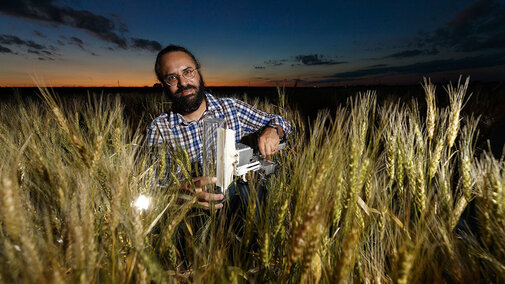New research from the University of Nebraska–Lincoln has led to the discovery of a novel gene that improves drought adaptation in wheat — a breakthrough that could contribute to increased world food security.
In new research published in Plant Biotechnology Journal, Harkamal Walia, associate professor and Heuermann Chair of Agronomy and Horticulture at Nebraska, and colleagues describe a novel form of a gene obtained from wild wheat that has the potential to improve drought tolerance in cultivated wheat. Introducing this gene into cultivated wheat improved the plant root structure so that it continued to grow in search of water under dry soil conditions.
Wheat is the most widely grown crop in the world and, together with rice, provides more than 50% of the caloric intake of humans globally. Like other crops, wheat is exposed to a wide range of environmental limitations, such as high temperature, disease pressure and drought.
The scavenging nature of wheat root systems during times of drought may have been lost when wild wheats were adopted for agriculture by early humans or as cultivated wheat was bred for improved responsiveness to irrigation and fertilizers during the mid-1900s. This improved responsiveness was key to feeding a booming world population during the 1960s.
As today’s producers strive for “more crop per drop” to feed a world population that is again in the midst of a boom and is expected to grow from about 7.5 billion today to more than 9.6 billion by 2050, it is evident that future crops will need greater drought resilience. The discovery by Walia and his colleagues could represent an important new genetic resource, enabling breeders to recapture this natural survival trait in cultivated wheat. The University of Nebraska–Lincoln has secured a patent on the discovery via NUtech Ventures, enabling future commercialization of this technology.
The potential impact of the discovery grew substantially when the team found that adding the wild root gene also resulted in plants with larger grains in the absence of drought. Walia and his team were not expecting this, as introducing tolerance to a stress can sometimes result in lost productivity when the stress is absent.
“This particular trait may have the opposite effect, which is a benefit in both conditions,” Walia said. “We are now working to understand the reason behind this surprising finding.”
The genetic engineering of wheat plants was performed at Nebraska’s Center for Biotechnology.
Walia is one of many researchers worldwide helping to develop a catalog of genes that will contribute to creating more robust plants for the future. Drought response is a complicated trait, Walia said, which involves many genes contributing to survival and productivity when water is limited. He hopes that research in this area will continue to discover new genetic resources that plant breeders and geneticists can use to develop more drought-tolerant crops.
“From a genetic improvement perspective, it takes a community to make a crop more adaptive,” Walia said. “This finding is one piece of a very large puzzle.”
The research was spearheaded by doctoral students Dante Placido and Jaspreet Sandhu in the Department of Agronomy and Horticulture. The work was supported by the Institute of Agriculture and Natural Resources and the Robert B. Daugherty Water for Food Global Institute.

